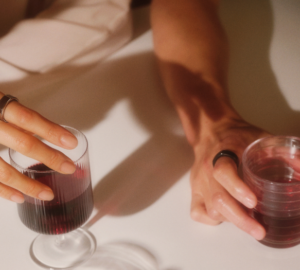Whether you’re trying to conceive or learn more about your body, it can be helpful to know when you’re fertile. This time of the month is known as the fertile window. But what does the fertile window mean, and how can you track it?
For Oura members, estimating this part of your cycle is now even easier. With the addition of Fertile Window to Oura’s Cycle Insights feature, tracking these key days is more intuitive than ever before.*
| Note: Oura’s Fertile Window feature is not intended to be used for contraception, and doing so may lead to unintended pregnancy. For a hormone-free birth control option, try Natural Cycles, powered by Oura. |

What Is the Fertile Window?
Fertile window meaning: The time during the menstrual cycle when you’re most likely to get pregnant.
Ovulation is triggered at the end of the follicular phase when the pituitary gland releases a surge of a hormone called luteinizing hormone (LH). While the egg is viable for around 24 hours after ovulation, the fertile window (or ovulation window) typically spans six to seven days. Why?
Sperm can survive in the uterus for up to five days after ejaculation. This means sperm released on Monday, for example, can fertilize an egg as late as Saturday, depending on the timing of ovulation.
Why Your Fertile Window Matters
“Understanding your fertile window is key to improving your body literacy, cycle awareness, and your overall reproductive health,” notes Dr. Neta Gotlieb, Women’s Health Senior Product Manager at Oura. No matter which stage of life you’re in, knowing the innate rhythms of your body can feel very empowering and educational.
Tracking your fertile window with Oura also takes one thing off your plate if you’re trying to conceive. “One of the things I repeatedly hear from fertility clinicians is how stressful it is for their patients to actively track their fertile window,” says Dr. Gotlieb. “We created the Fertile Window feature to help minimize this stress with passive tracking and empower women through self-knowledge.”
How Does Oura Estimate Ovulation?
 The Fertile Window feature uses two algorithms to predict and detect your most fertile days based on your past cycles and physiological data, including heart rate, heart rate variability, temperature trends, and respiratory rate.
The Fertile Window feature uses two algorithms to predict and detect your most fertile days based on your past cycles and physiological data, including heart rate, heart rate variability, temperature trends, and respiratory rate.
Your body’s temperature trends, in particular, are robust signifiers for ovulation, and thus, your fertile window. At the end of the follicular phase, during the periovulatory (pre-ovulatory) and ovulatory phases (your fertile days), estrogen levels begin to climb and then luteinizing hormone (LH) levels surge and trigger the release of an egg from the ovarian follicle (i.e. ovulation).
Post-ovulation, the ovarian follicle collapses to become the corpus luteum (aka “the yellow body”). The corpus luteum produces progesterone, which causes body temperature to rise. This, along with other biomarkers and data, enables Oura’s algorithm to identify the days you’re most likely to conceive.
If fertilization occurs, the fertilized egg will travel to the uterus and begin the process of implantation. If fertilization doesn’t occur, the next cycle will begin with menstruation and you’ll receive new ovulation and fertile window estimates.
If you’re looking ahead for your ovulation date and fertile window, keep in mind that they are only estimates, Dr. Gotlieb notes: “These estimates can be helpful, but remember, until ovulation is confirmed through a rise in temperature or by tagging a positive LH test, they’re subject to change.”
For the most accurate predictions, remember to log your period each cycle in the Oura App.
Why Your Fertile Window May Shift
The human body doesn’t work like clockwork, so the timing of your fertile window may shift cycle to cycle due to factors such as stress, illness, or even travel or exercise.
After all, it’s a myth that ovulation occurs on day 14 and that everyone experiences a 28-day cycle. The truth is that menstrual cycles vary widely: based on anonymized Oura member data, cycles vary in length from 20-40 days, and each individual can experience a variation of +/- 8 days, so the timing of your fertile window shifts too.
In fact, one study found that only 30% of women have a fertile window that falls within the days identified by clinical guidelines—that is, between days 10 and 17 of their menstrual cycle.
Why You May Not See a Predicted Fertile Window
A number of issues could lead to a lack of fertile window predictions, including:
- Your initial 60 nights of data haven’t accumulated yet
- You haven’t worn your ring consistently while sleeping
- You haven’t synced your Oura App
- You haven’t been logging your periods
- Network error
- Lack of physiological pattern
If there is a lack of physiological pattern, this could be due to:
- A short-term factor that made it difficult to determine your fertile window for this month, such as alcohol, sickness, medication, jet lag, stress, or a one-off anovulatory cycle.
- A long-term factor that consistently makes it difficult to determine your fertile window, such as taking hormones, coming off of hormones in the past 6 months, pregnancy, persistent anovulatory cycles (you repeatedly do not ovulate every month), or coming off of hormones for 6+ months without menstruation.
If you persistently do not see fertile window predictions after troubleshooting the above potential issues, then you might want to discuss your cycle history and temperature graph with your doctor. It’s perfectly healthy to get a one-off anovulatory cycle where you do not ovulate that month, but a persistent lack of pattern in your temperature data every month could indicate an underlying issue.
READ MORE: How Oura Data Can Help You Understand Your Menstrual Cycle
*Fertile Window is designed to aid conception and support body literacy, not as a method of birth control. For a hormone-free option for birth control, check out Natural Cycles, powered by Oura.
The predictions and insights provided are based on general patterns and algorithms that analyze your body’s signals, but they cannot account for every individual variation or unexpected cycle change.
Fertile Window is available in select countries only. Learn more here.
About the Oura Expert
Neta Gotlieb, Ph.D., is a Senior Product Manager and Women’s Health Lead at ŌURA researching and developing solutions focused on women’s health. Dr. Gotlieb received her Master’s degree from Tel Aviv University in Biological Psychology where her work focused on how stress impacts immune function and endocrine pathways. She earned a PhD from UC Berkeley where she studied Reproductive Neuroendocrinology and the circadian regulation of menstrual cycles, pregnancy, and birth. Dr. Gotlieb has received the Women in Tech Global Technology Leadership Award and has been named one of the Women of Wearables’ Trailblazing Leaders in Women’s Health and FemTech. She’s also the author of the children’s book Every Body’s Brain.











